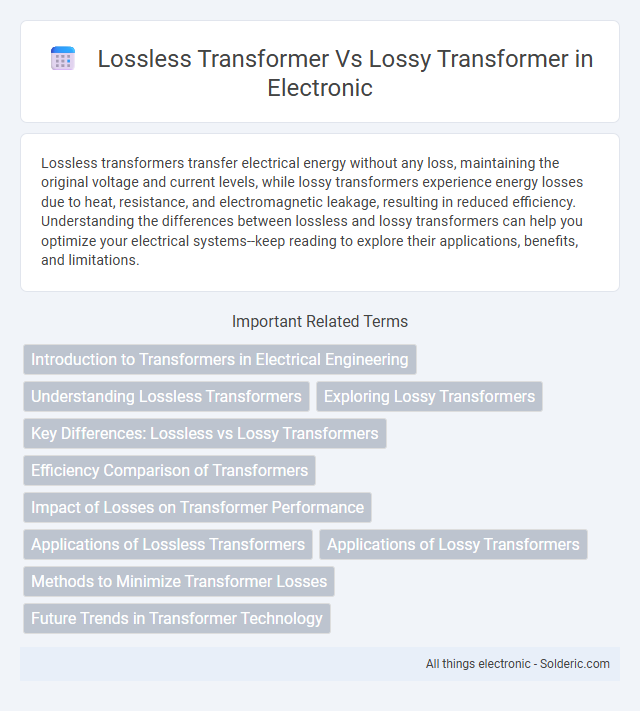Lossless transformers transfer electrical energy without any loss, maintaining the original voltage and current levels, while lossy transformers experience energy losses due to heat, resistance, and electromagnetic leakage, resulting in reduced efficiency. Understanding the differences between lossless and lossy transformers can help you optimize your electrical systems--keep reading to explore their applications, benefits, and limitations.
Comparison Table
| Feature | Lossless Transformer | Lossy Transformer |
|---|---|---|
| Definition | Processes data preserving original information without any loss. | Processes data with some information loss for efficiency or compression. |
| Data Integrity | 100% data retention, full fidelity output. | Partial data retention, possible reduced fidelity. |
| Use Cases | Critical applications needing exact data reproduction (e.g., medical, legal). | Applications tolerant to approximations (e.g., audio/video compression, summarization). |
| Model Complexity | Typically higher complexity to ensure no information loss. | Often simpler or optimized for speed and resource efficiency. |
| Output Quality | Exact replication of input data. | Approximate representation with acceptable quality trade-offs. |
| Performance | Lower speed due to full data preservation. | Higher speed leveraging data reduction. |
Introduction to Transformers in Electrical Engineering
Transformers in electrical engineering are devices designed to transfer electrical energy between circuits via electromagnetic induction, with key types including lossless and lossy transformers. Lossless transformers ideally exhibit no energy dissipation, ensuring maximum efficiency by minimizing resistive and core losses, whereas lossy transformers experience energy losses due to factors such as winding resistance, hysteresis, and eddy currents. Understanding these distinctions is critical for optimizing transformer design, enhancing power transmission efficiency, and minimizing operational costs in electrical systems.
Understanding Lossless Transformers
Lossless transformers maintain the integrity of the input information by preserving data precision during the transformation process, ensuring no information is discarded or altered. This characteristic is crucial in applications like image compression and signal processing where exact reconstruction of the original data is required. In contrast, lossy transformers reduce data size by approximating the input, which can result in some loss of detail or quality.
Exploring Lossy Transformers
Lossy transformers reduce data size by discarding some information, leading to efficient compression but potential degradation in signal quality. These transformers are commonly used in applications like audio and image compression where perfect fidelity is not critical. When exploring lossy transformers, you must consider the trade-off between compression ratio and quality loss to suit your specific needs.
Key Differences: Lossless vs Lossy Transformers
Lossless transformers maintain energy efficiency by ensuring minimal power loss during voltage conversion, preserving the integrity of the electrical signal, while lossy transformers experience power dissipation due to core and copper losses. Your choice between lossless and lossy transformers depends on the application requirements, with lossless being ideal for precision equipment and lossy transformers suited for general power distribution where some energy loss is acceptable. Understanding these key differences allows you to optimize performance, reliability, and energy consumption effectively.
Efficiency Comparison of Transformers
Lossless transformers maintain nearly 100% energy transfer efficiency by minimizing core and copper losses through high-quality materials and optimized winding techniques. In contrast, lossy transformers experience reduced efficiency due to higher hysteresis, eddy current losses, and resistive heating in their cores and coils. When selecting a transformer, understanding how loss characteristics affect your system's overall energy consumption is crucial for optimizing performance and cost-effectiveness.
Impact of Losses on Transformer Performance
Losses in transformers, primarily core and copper losses, significantly affect their efficiency and temperature rise, reducing overall performance. Lossless transformers theoretically maintain energy transfer without degradation, ensuring maximum efficiency and minimal heat generation, which is ideal for precision applications. Your choice between lossless and lossy transformers should consider the impact of these losses on energy savings, reliability, and long-term operational costs.
Applications of Lossless Transformers
Lossless transformers are widely used in applications requiring precise power measurement and protection, such as in metering transformers for utility grids and instrumentation transformers for sensitive electronic equipment. Their ability to maintain the original waveform without distortion makes them ideal for accurate signal transmission in relay protection and power quality monitoring systems. These transformers ensure minimal energy loss, enhancing efficiency in critical industrial and communication infrastructures.
Applications of Lossy Transformers
Lossy transformers are commonly used in applications requiring signal conditioning, such as audio processing and power systems, where energy dissipation through core losses helps stabilize voltage and reduce noise. Your electronic devices benefit from lossy transformers in scenarios demanding controlled impedance and isolation to prevent signal distortion. These transformers are essential in scenarios prioritizing efficiency and noise filtering over minimal energy loss.
Methods to Minimize Transformer Losses
Lossless transformers employ advanced design techniques such as high-quality magnetic core materials with low hysteresis and eddy current losses to minimize energy dissipation. Precise winding arrangements and optimized conductor sizes reduce resistive (I2R) losses, enhancing efficiency. In contrast, lossy transformers may prioritize cost over efficiency, using standard materials and less stringent manufacturing processes that result in higher thermal and magnetic losses.
Future Trends in Transformer Technology
Future trends in transformer technology emphasize the development of lossless transformers to enhance energy efficiency and reduce heat dissipation in power systems. Advanced materials like amorphous metal cores and improved manufacturing techniques aim to minimize core losses, outperforming traditional lossy transformers. Integration with smart grid technology and real-time monitoring further drives optimization and reliability in transformer performance.
lossless transformer vs lossy transformer Infographic

 solderic.com
solderic.com